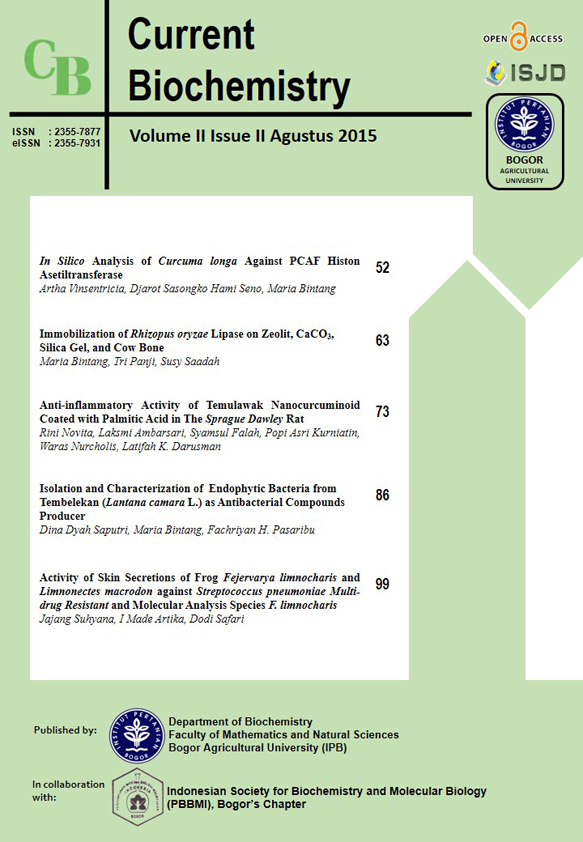Immobilization of <i>Rhizopus oryzae</i> Lipase on Zeolit, CaCO<sub>3</sub>, Silica Gel, and Cow Bone
Abstract
Food production in Indonesia is constrained by the high cost of lipase that is still imported from abroad. To overcome this problem, research of food production has been conducted using crude extract of lipase produced by indigenous species of fungi Rhizopus oryzae. The R. oryzae is edible indicating that it is safe to be used in the production of food products. Enzymes have an ability to catalyze specific chemical reactions with high efficiency and low energy cost. Enzyme immobilization is a recovery techique that has been studied in several years, using supporting materials as a medium to help enzyme dissolutions to the substrate. Several supporting materials such as zeolit, CaCO3, silica gel, and cow bone were selected by its ability to adsorb lipase. CaCO3 shows enzyme loading rate respectively 99.46%, giving more lipase to adsorb than zeolit (90.69%), cow bone (91.56%), and silica gel (59.63%). In this research, condition factors, such as optimum pH, optimum temperature, and storage ability of the matrix were investigated. Free lipase reacts optimally at pH 7 and temperature 30°C. Identical result showed for lipase in cow bone. Lipase in CaCO3 reacts optimally at pH 8 and temperature 35°C. Lipase in zeolit and silica gel reacts optimally at pH 8 and temperature 30°C. Half life time estimation was one week in storage condition temperature at 4°C and each optimum pH.References
Apriyanti S. 2012. Optimasi Produksi Diasilgliserol dari CPO dengan Biokonversi Enzim Lipase Spesifik 1,3 Amobil [Skripsi]. Bogor (ID) : Universitas Pakuan.
Datta S, Christena LR, Rajaram YRS. 2013. Enzyme immobiliation: an overview on techniques and support materials. Journal Biotech. 3:1-9. DOI:10.1007/s13205-012-0071-7
Ghamgui H, Chaabouni MK, Gargouri Y. 2004. 1-butyl oleate synthesis by immobilzed lipase from Rhizopus oryzae: a comparative study between n-hexane and solvent free system. Enzyme and Microbial Technology. 35:355-363. DOI: 10.1016/j.enzmictec.2004.06.002
Ibegbulam-njoku PN, Achi OK, Chijioke-Osuji CC. 2014. Use of palm oil mill effluent as fermentative medium by lipase producing bacteria. International Journal of Sciencetific & Engineering Research. 5(2):1631-1640. DOI: 10.1590/S1516-89132011000100015
Kharrat N, Yassine BA, Sana M, Youssef-Talel G, Maha K. 2011. Immobilization of Rhizopus oryzae lipase on silica aerogels by adsorption: Comparison with the free enzyme. Process Biochemistry. 46:1083-1089. DOI:10.1016/j.procbio.2011.01.029
Kilinc A, Mustafa T, Azmi T. 2006. Immobilization of pancreatic lipase on chitin and chitosan. Prep Biochem Biotechnol. 36:153-163. DOI: 10.1080/10826060500533976
Kirk, O. Vedel T. Crone C. 2002. Industrial Enzyme Application. Current opinion on biotechnology. 13:345-351. DOI: 10.1016/S0958-1669(02)00328-2
Lee DH, Kim JM, Kang SW, Lee JW, Kim SW. 2006. Pretreatment of lipase with soybean oil before immobilization to prevent loss of activity. Biotechnol Lett. 28:1965-1969. DOI: 10.1007/s10529-006-9181-9
Nelson DL, Cox MM. 2008. Lehninger: Principles of Biochemistry 5th Edition. New York: WH Freeman and Company.
Palilingan SC. 2013. Optimasi produksi enzimatis diasilgliserol dari CPO dengan sistem kontinu [tesis]. Bogor (ID): Institut Pertanian Bogor.
Panesar PS, Marwaha SS, Chopra HK. 2010. Enzymes Food Processing: Fundamental and Potential Application. New Delhi: International Publishing House Pvt. Ltd.
Panji T, Suharyanto, Arini N. 2008. Lipase Spesifik 1,3-Gliserida dari Fungi Lokal Untuk Biokonversi CPO Menjadi Diasilgliserol. Menara Perkebunan. 76(1):11-22.
Panji T, Syamsu K, Suharyanto, Fathurachman I. 2010. Amobilisasi desaturase asal Absidia corymbifera menggunakan butiran tulang sapi dan zeolit. J. Tek. Ind. Pert. 11(3):101-107.
Pereira EB, Castro HF, Moraes FF, Zanin GM. 2001. Kinetic studies of lipase from Candida rugosa : a comparative study between free and immobilized enzyme onto porous chitosan beads. Appl. Biochem. Biotechnol. 91:739–752. DOI: 10.1007/978-1-4612-0217-2_62.
Perwitasari U. 2008. Optimasi Produksi Enzimatik dan Isolasi DAG dari CPO [tesis]. Bogor (ID): Institut Pertanian Bogor.
Reda BA, El-louboudey SS, Sidley NM, Abd El-Rahman MA. 2007. Production, purification and characterization of thermoalkalophilic lipase for application in bio-detergent industry. J.Appl. Sci Res, 39(12):1752-1765. DOI: 10.1016/j.biotechadv.2009.06.001.
Shah AA, Hameed A, Hasan F. 2009. Methods for detection and characterization of lipases: A comprehensive review. Biotechnology Advances 27:782-796. DOI: 10.1016/j.biotechadv.2009.06.001.
Wang K, Yang H, Zhu L, Liao J, Lu T, Xing W, Xing S, Lv Q. 2009. Direct electrochemistry and electrocatalysis of glucose oxidase immobilized on glassy carbon electrode modified by nafton and ordered mesoporous. Journal of Molecular Catalysis B: Enzymatic 58: 194-198.
Wulan M, Rejoso MT, Hermansyah H. 2007. Seminar Tjipto Utomo. Bandung, 30 Agustus 2007.
Yesiloglu Y dan Sit L. 2011. Biochemical properties of free and immobilized Candida rugosa lipase onto Al2O3: a comparative study. Artificial cells, blood substitutes and bitechnology. 39:247-251. DOI: 10.3109/10731199.2010.533125.
Zou B, Hu Y, Cui F, Jiang L, Yu D, Huang H. 2014. Effect of surface modification of low cost mesoporous SiO2 carriers on the properties of immobilized lipase. Journal of Colloid and interface science. 417:210-216. DOI: 10.1016/j.jcis.2013.11.029.













